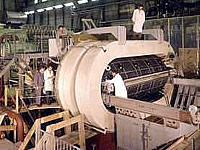history
... these are the most significant historical events related to bubble chambers ...

one of the first ones

one of the last ones (Gargamelle)
Donald GLASER invented a bubble chamber.
The first bubble chambers were made of Pyrex glass and contained a few cubic centimeters of liquid.
1959
Nobel Prize for Emilio SEGRE (US) and Owen CHAMBERLAIN (US), for demonstrating
the existence of the anti-proton. (more details...)
1960
Nobel prize for Donald A. GLASER (US), for invention of "bubble chamber"
to study subatomic particles.
1968
Nobel prize for Luis Walter ALVAREZ (US)
He was awarded the 1968 Nobel Prize in Physics for his discovery of a
large number of resonance states (subatomic particles that have very short
lifetimes and that occur only in high-energy nuclear collisions), which
was made possible through his development of the liquid-hydrogen bubble
chamber.
1969
Nobel prize for Murray GELL-MANN (US), for study of subatomic particles.
In 1961 GELL-MANN and Israeli physicist Yuval NE'EMAN independently introduced
the "eightfold way," or SU(3) symmetry, a table like ordering
of all subatomic particles analogous to the ordering of the elements in
the periodic table. The 1964 discovery of the omega-minus particle (from
a bubble chamber picture), which filled a gap in this ordering, brought
the theory wide acceptance and led to GELL-MANN's being awarded the 1969
Nobel Prize for Physics. In 1963, GELL-MANN and American physicist George
ZWEIG independently postulated the existence of the quark, an even more
fundamental elementary particle with a fractional electric charge. Quarks
are confined in protons, neutrons, and other particles.
1973
Neutral currents were discovered at CERN in 25 ton Gargamelle bubble chamber.
1974
7-foot Brookhaven bubble chamber started to operate.
This was the first particle detector of its type in which the chamber
through which the particles passed was surrounded by a superconducting
magnet. The following year, the 7-foot chamber was used to discover the
charmed baryon, a particle composed of three quarks, one of which was
the "charmed" quark. This result helped physicists confirm a
new member of the quark family.